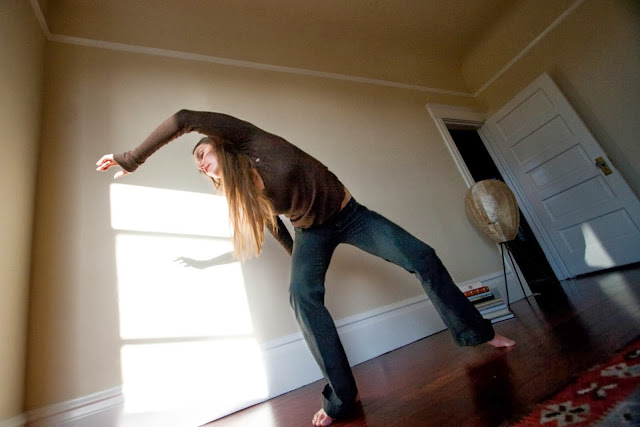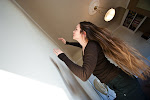I drove out to Mills College to see Yvonne Rainer today. She had been teaching Trio A in the morning, and in the afternoon she would talk. I had noticed an e-mail announcing this event just this morning and thought I shouldn't let a chance to meet a legend go by. I was totally unprepared to what my own reaction would be upon actually witnessing Rainer's lecture.
Ms. Rainer was introduced, and she walked on to the stage while I found myself crying huge tears (and getting embarrassed and trying to hide the fact from her). For the first time in my life I realized just how big an influence Yvonne Rainer's and her Judson Church colleagues' work had had on my life - decades later after the Judson Memorial Church group was active.And I mean my life, much more than my work, at least directly.
One of the things she mentioned was how she comes from John Cage. That was the actual way she expressed it: "I come from Cage." Although I never met him I have a personal relationship with him, too. John Cage visited the Kuhmo Chamber Music Festival in Finland when he was already an old man, and I saw tv-footage of that gig when I was very young. Seeing him talking to people and making music out of breaking sticks and the silence in between changed 1: my understanding of music, 2: my understanding of what composing is, and 3: my outlook on life. During that tv-program I became a part of the paradigm shift of which John Cage was one of the main proponents.
This was possible although there were several generations between Cage and me. I had spent my childhood in ballet school, and was raised by two ballet dancers. My idea of creativity and creating was hierarchic. My idea of what dance and music are, was pitiably narrow. Well, that changed, and it felt as a great liberation.
I read about Yvonne Rainer and Judson Church a few years later. That was an encouragement to continue the search for my own choreographic vision. It wasn't easy and it wasn't fast, but since then I have done dance.
Contrary to what I have decided earlier about writing a blog this became a very personal posting, and one that has no direct link to making of performing art in practice. I just owe thank yous to all the courageous artists who have done work that broke away from the tradition. Thank you for the freedom.
Sunday, January 31, 2010
Tuesday, January 5, 2010
Concentration
I stepped back from my concentration for a moment today in Frey Faust's class and looked at my fellow students. What I saw was a lot of people all investing hard in moving and understanding. There was a sincerity on every face. I'm still smiling as I write this.
I like watching people do their work, or something they love doing. There is something very intimate in full concentration. Seeing that feels like a privilege granted. When I choreograph, or see somebody dance, I prefer dancers to have that attention to movement. I don't want to see anyone go through the moves, I want to witness them rediscovering them.
Laura Bernasconi, a lovely ballet teacher, has spoken of dancing with the ego versus NOT dancing with the ego. She was proposing to her students to let the choreography guide them instead of willing themselves to perform well.
My interpretation of the issue is to concentrate in the movement, on all of it's levels. A dancer needs to manage their body in time and space, and that pretty much fills the mind at the moment of the dance, at least for me. Through that thorough attention it is possible to reach an irreplaceable happiness. Dancing becomes meditation rather than a show. I wish I had the magic words to reach that state every time.
Music is another lifesaver. (Or a precipice, considering how much there is unnecessary mood music in films, theater and dance shows.) To get to mention a third of my favorite dance things in addition to Frey and Laura, the fully rounded - ecstasy producing - flamenco wholeness needs to be listed here. In flamenco, compas is everything. Without compas - no flamenco. It is a 12 count rosary that demands total surrender and weaves together music, dance and lyrics.
The best definition of a performer's presence I have ever heard of, is similar to that. The total presence a dancer grants to their movement translates as something that is often described as stillness, or stage presence. Today at Frey Faust's class I had a glimpse of several individuals surrendering to that simultaneously. Must be beautiful being able to facilitate that.
So there is an extra dimension, that good old together but as individuals experience. It is crucial in social dancing, but a performance situation is a social situation as well. The performers and the audience are doing something together. To get there we need the tools of letting go of the ego thing.
Here a link to a TED talk about creativity. At the very end something worth hearing about dance.
http://www.ted.com/talks/lang/eng/elizabeth_gilbert_on_genius.html
I like watching people do their work, or something they love doing. There is something very intimate in full concentration. Seeing that feels like a privilege granted. When I choreograph, or see somebody dance, I prefer dancers to have that attention to movement. I don't want to see anyone go through the moves, I want to witness them rediscovering them.
Laura Bernasconi, a lovely ballet teacher, has spoken of dancing with the ego versus NOT dancing with the ego. She was proposing to her students to let the choreography guide them instead of willing themselves to perform well.
My interpretation of the issue is to concentrate in the movement, on all of it's levels. A dancer needs to manage their body in time and space, and that pretty much fills the mind at the moment of the dance, at least for me. Through that thorough attention it is possible to reach an irreplaceable happiness. Dancing becomes meditation rather than a show. I wish I had the magic words to reach that state every time.
Music is another lifesaver. (Or a precipice, considering how much there is unnecessary mood music in films, theater and dance shows.) To get to mention a third of my favorite dance things in addition to Frey and Laura, the fully rounded - ecstasy producing - flamenco wholeness needs to be listed here. In flamenco, compas is everything. Without compas - no flamenco. It is a 12 count rosary that demands total surrender and weaves together music, dance and lyrics.
The best definition of a performer's presence I have ever heard of, is similar to that. The total presence a dancer grants to their movement translates as something that is often described as stillness, or stage presence. Today at Frey Faust's class I had a glimpse of several individuals surrendering to that simultaneously. Must be beautiful being able to facilitate that.
So there is an extra dimension, that good old together but as individuals experience. It is crucial in social dancing, but a performance situation is a social situation as well. The performers and the audience are doing something together. To get there we need the tools of letting go of the ego thing.
Here a link to a TED talk about creativity. At the very end something worth hearing about dance.
http://www.ted.com/talks/lang/eng/elizabeth_gilbert_on_genius.html
Subscribe to:
Posts (Atom)


